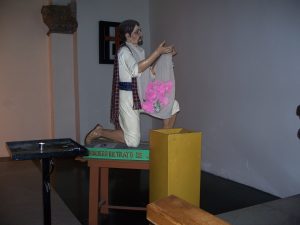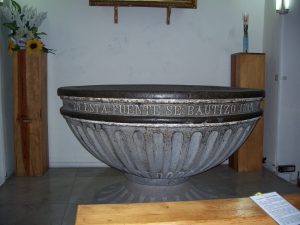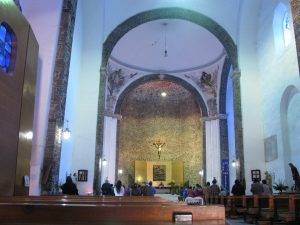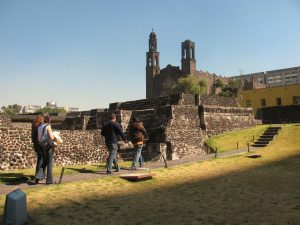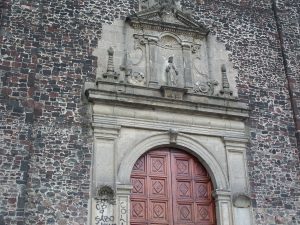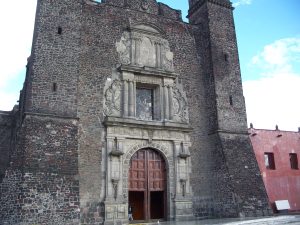Monthly Archives: February 2024
ST. JUAN DIEGO’S FIRST CHURCH, Tlaltelolco, Mexico City
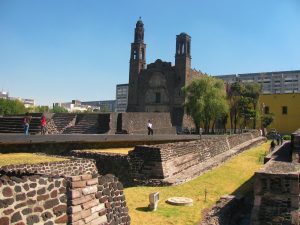
In 1518, a typical day in Tlaltelolco in the Aztec empire saw thousands of people milling about, trading, selling, bartering and buying. The town’s bustling marketplace was the largest in the sprawling empire. At the hub of all this activity stood the massive temple and its twin pyramids dedicated to the pagan gods, Huitzilopochtli and Tlaloc. The emperor, Montezuma ll, presided over this vast domain. But not for much longer.
Within three years, life for the Aztecs would be radically altered: Tlaltelolco would become a Christian stronghold and a church would be built on the site of the pagan temple.
This church, named after St. James, the Apostle, the patron of Spain, would be the place where Juan Diego, the most renowned visionary in the Americas, would be baptized and receive catechetical instructions.
He would be headed here on that momentous Saturday morning of December 9, 1531, when he would encounter Our Lady of Guadalupe for the first time.
Ten years earlier, in 1521, the course of Mexican history changed forever. That was the year that the Spanish conquistador Hernan Cortez, defeated the last Aztec emperor, Cuauhtemoc, at Tlaltelolco in the final battle for the conquest of Mexico. Montezuma had died a year earlier. A plaque at the site poignantly tells of the battle: “On Aug. 13, 1521, heroically defended by Cuauhtemoc, Tlaltelolco fell to Hernan Cortez. It was neither a triumph nor a defeat but the birth of the mestizo nation that is the Mexico of today.”
In 1524, the first band of missionaries, twelve Franciscans—popularly called “the twelve apostles”—landed in New Spain (Mexico) for the first time and organized a center of evangelization at Tlaltelolco. Juan Diego, along with his wife (who died in 1529) and uncle, were among the first Christians in the newly conquered country. They were baptized in 1525. Juan Diego was a disciple of one of these “twelve,” Fray Torobio Paredes de Benavente, who was renowned for his humility and saintliness
A Franciscan convent was founded at Tlaltelolco in 1535 and the Church of St. James was built in 1543. Bernal Diaz, a soldier who fought alongside Cortes in the battle for Mexico, speaks of this church in his acclaimed account, The Conquest of New Spain: “After we conquered the great and strong city (Tlaltelolco) we decided to build a church to our patron and guide, St. James, in place of that of Huichilobos’ cue (temple)—and a great part of the site was taken for this purpose.”
Diaz described the frightening image of Huichilobos, which he saw on an altar: It was “giant-sized” with a “very broad face and huge terrible eyes.” Another image he described was that of Tezcatlipoca, the god of hell—it was surrounded by figures of devils with snakes’ tails.”
Not only was the church built on the site of the razed temple, it was built with the very stones of the razed temple. This was a common practice in the building of the earliest colonial churches in New Spain. Its purpose was twofold: to signify that the Christian religion is the one true religion and supplants the former pagan religion. The excavated ruins of the temple and pyramids—they are mammoth—are visible today. “The pyramids were the height of a skyscraper,” reports one historian.
The gargantuan, “fortress-like” Church of St. James is typical of the austere style of 16th century Franciscan architecture. The interior follows suit: The ultramodern interior of the single nave church is characterized by a stark and unadorned simplicity. Directly inside the central (west) doors of the church is the baptismal font in which Juan Diego was baptized. Nearby is a life-size statue of Juan Diego kneeling in front of a painting of Our Lady of Guadalupe. He is displaying his tilma (cloak) which holds an array of three-dimensional, petal-pink Castilian roses. The drama is of Guadalupe is about to begin!
WHERE IT ALL BEGAN:
Adjoining the church is the vermilion-red Franciscan convent of the Holy Cross, the place where Juan Diego attended weekly catechism classes and Saturday Masses in honor of the Blessed Virgin Mary.
The miraculous appearance of the image of Our Lady of Guadalupe on Juan Diego’s tilma occurred on Dec. 12, 1531. He spent the rest of his life as protector of the blessed image, living in the hermitage, the first church built to house the miraculous painting. Until his death in 1548, he devoted his days to prayer, contemplation and evangelization. Today the Basilica of Our Lady of Guadalupe is the most visited shrine in the world, with 20 million pilgrims a year. Juan Diego was canonized by Pope John Paul ll in 2002. An astonishing 12 million people lined the streets of Mexico City to welcome the Pope as he arrived for the ceremony. And to think—it all began here in the Church of St. James in Tlatelolco.
Mary Hansen
RERINTED WITH PERMISSION FROM THE NATIONAL CATHOLIC REGISTER.
The name of this website has been changed to mexicanmadonnas.com
